From production tothirty-twoDuring the Zhou age period, the weight of one day old chicks produced by a mother hen is directly proportional to the mother hen's Zhou age, and thereafter the weight of the chicks gradually stabilizes. During this period, chicks produced by hens are usually referred to as primiparous chicks.
Newborns hatch with smaller embryos, lower cell survival rates, and more premature deaths. Due to developmental differences, the eggs of newly hatched chicks may be less tolerant to prolonged storage.
Newborns and normal chicks have the same genetic potential, and with proper management, they can achieve the same production results as normal chicks.
Based on the physiological characteristics of newborn chicks and practical experience on site, we have summarized the following management points.
Temperature management
First born chicks are highly intolerant to low temperature environments. During the hatching process, the eggs of newly hatched chicks produce less heat. First born chicks also produce less heat per unit body weight (not to mention their already lighter weight). When the temperature is too low, newly hatched chicks do not 'scream' as frequently as other chicks. But it is a quiet way to withstand the impact of low temperature, so that managers are less likely to notice that the temperature is already very low. The one week mortality rate of newly hatched chicks on the breeding site is usually high, especially in chicken coops or when the ground temperature is too low.
Excessive temperature can also have adverse effects on newly hatched chicks. Stress such as dehydration caused by overheating will also be more pronounced. Overheated chicks will keep panting and have a high anal temperature, with an average offorty-one point oneCelsius degrees, while chicks in comfortable environments are only averagefortyCelsius degree(one hundred and four°F)The anal temperature. Chicks subjected to heat stress have slight damage to their intestines, so they cannot absorb nutrients well.
Therefore, for first-time chicks, the top priority of management is to ensure that they are always under suitable temperature conditions in order to achieve ideal production results.
Chicks at the beginningfiveHeaven has no ability to regulate body temperature untiltwoThis ability gradually improved during Zhou Da's reign (see figure below). Prior to this, their temperature regulation was known as variable temperature (commonly known as cold-blooded) body temperature regulation. This means that, like snakes and other reptiles, the body temperature of chicks fluctuates with the ambient temperature. When the ambient temperature is high, the temperature of the chicks will also be high. If the ambient temperature is low, the temperature of the chicks will be low. Therefore, the survival of chicks highly depends on the appropriate environmental temperature we provide.
For newly hatched chicks, the transition from temperature regulation to constant temperature regulation may also take slightly longer. They are more sensitive to the decrease in temperature. Therefore, more careful care is needed.
In order to effectively control the body temperature of chicks during the critical stage of temperature regulation and ensure that first-time chicks achieve equivalent production results.We have developed the following temperature management guidelines for primiparous chicks.
Key points of temperature management: temperature program and pre temperature of chicken coop
For newborn chicks:
· & nbsp; The target for air temperature is34-35centigrade
· & nbsp; The target temperature for padding is30-32centigrade
· & nbsp; The temperature of the concrete floor should be higher thantwenty-eightcentigrade
· & nbsp; frontfourteenPreviously, the temperature could never be lower than the target temperatureonecentigrade
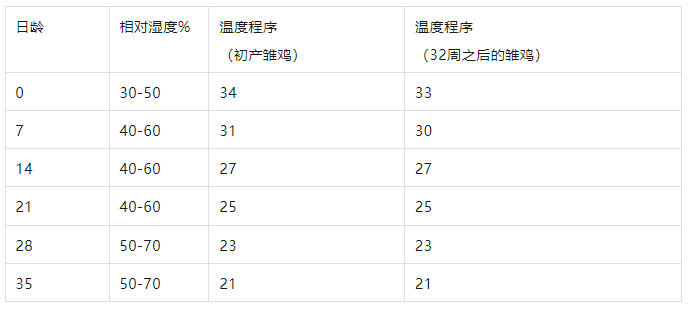
When raising chicks in winter, the chicken coop should be preheated at least three days in advance. Because only when the floor and walls of the chicken coop absorb a large amount of heat, can the air and bedding inside the coop obtain a stable temperature for raising chicks. Insufficient preheating time can lead to frequent fluctuations in the temperature of the chicken coop and chicks upon arrival, affecting their growth and development during critical life periods.
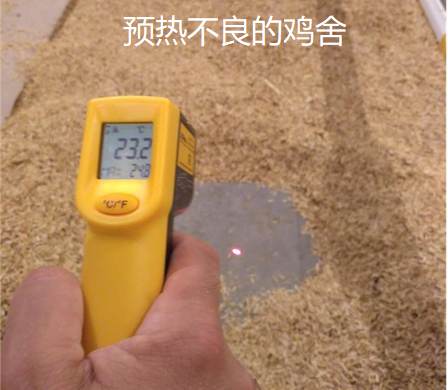
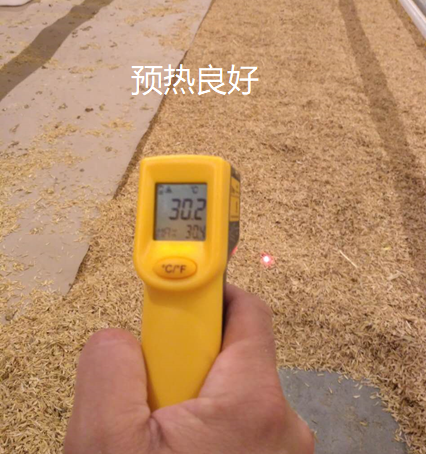
Because the feet of chicks directly touch the ground, the temperature of the ground can directly affect the body temperature of chicks.
To save fuel, the temperature of the chicken coop can be raised in stages. For example:
· & nbsp; Before the arrival of chicks72-48Hour: Preheat toeighteencentigrade
· & nbsp; Before the arrival of chicks48-24Hour: Preheat totwenty-twocentigrade
· & nbsp; Before the arrival of chicks24-12Hour: Preheat totwenty-eightcentigrade
· & nbsp; Before the arrival of chickstwelveWithin hours: Preheat to target temperature
& nbsp;
When measuring temperature, random measurements cannot represent the true situation of the chicken coop. On the left, middle, right, and three sides of the chicken coop, every intervalsixChecking the temperature of the chicken coop can provide a better understanding of the overall temperature situation.
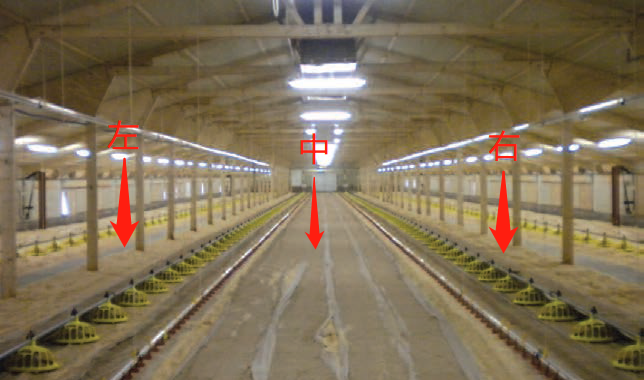
Key point 2: EducationChuchudensity
yesAt the beginningChick productionCan be appropriately improved in terms of educationChuchuThe density of the area. buildThe proposal isNormal nurturingChuchuDensity of1.1-1.2Twice.

Key point three:WhenmomentprisoncontrolchickBody temperature and vitalitymovestatus
After the chicken farmtwoMeasure the body temperature of the chicks around an hour and repeat it several times a day to ensure that the chicks maintain an appropriate body temperature. It is not recommended to immediately check body temperature upon arrival.
During each temperature check, it is divided intofiveGroup, each grouptenOnly, choose from different places in the chicken coop, totaling approximatelyfiftyA chicken. Calculate the average temperature of each group and thisfiftyThe average body temperature of a chick.
The normal body temperature of chicks is40-40.6Between Celsius degrees. higher thanforty-oneChicks will gasp for breath when the temperature is too high, belowfortyCelsius can cause clumping due to being too cold, and whether the anal temperature of chicks is normal is the main factor in evaluating whether environmental parameters are appropriate.stayfiveAt age, the average body temperature of chicks gradually increases to41-42centigrade.
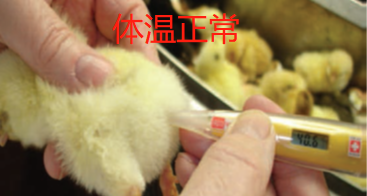
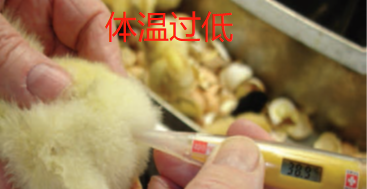
If the temperature is too low or too high (at this time, chicks often do not eat or drink water), make corresponding adjustments immediately.
The interaction between temperature, humidity, and the speed of air flow can all affect the body temperature and comfort of young chicks. In addition to checking body temperature, the activity status of chicks should also be evaluated regularly. It is easy to tell whether the chick feels uncomfortable:
· & nbsp; Too hot chicks make noise and gasp for breath in order to dissipate heat.
· & nbsp; Cold chicks will squeeze together to keep warm, and their legs feel very cold to the touch.

Drinking water management
During the idle period, it is necessary to choose suitable disinfection products to flush the water line and water ball, ensuring that the drinking water system is clean and tidy.
-
Before the chicks arrive at the house, they should rinse the water line. Additionally, due to the high temperature and slow water flow during the chick rearing period, the first two days requireone-twoRinse once every hour,thirtyThe meter long waterline needs to be washed for one minute. Avoid water temperature exceeding25 ℃The water temperature exceeds26.7 ℃It will affect water consumption and daily weight gain. Research has found that chickens enjoy drinking10-14℃For water, it is recommended not to place the water container inside the chicken coop. If it is inside the coop, even if every1~2Rinse once every hour, and the water temperature will quickly rise to the ambient temperature, reachingthirtyAround Celsius degrees, this will affect the drinking and feeding habits of chickens.
-
The waterline is too low, making it difficult for chicks to drink water, which can cause water pollution in their drinking cups. Flatten the waterline so that the chick's feet are flat on the ground but can reach the nipple.
-
Ensure that the nipples have sufficient water flow to provide additional water balls for the newborn chicks, allowing them tozero point fiveClean water can be consumed within a range of meters. The lighting in the chicken coop should be bright, allowing the water in the water dispenser or the water droplets hanging from the nipples to reflect light and attract chicks to drink water. When using a Prazon water dispenser to raise chicks, it is required that eachfourClean the water dispenser once every hour.Monitoring of nipple water intake: Excessive pressure on the circumferential waterline can cause difficulty for chicks to drink water from the nipple. The appropriate amount of nipple water intake represents the appropriate waterline pressure. The steps of detection are:a)Choose the nipple far from the regulator/That is, the other end of the waterline;b)Measure with a measuring cup, touch the nipple, and measure in a natural stateoneMinute water volume.The suitable traffic is shown in the table below:
-
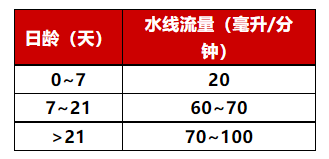
four & nbsp;After receiving seedlingstwoHour, make sure to75%The chick has water and food in its crop. Chicks are good monitors that can be used to test and evaluate your chick rearing work.
five & nbsp; Regularly sample and inspect water quality. For drinking water that uses active chlorine as a disinfectant,PHThe ideal value isfive-six point fiveBetween, oxidation-reduction potential (OPR)staysix hundred and fifty-750mvbetween.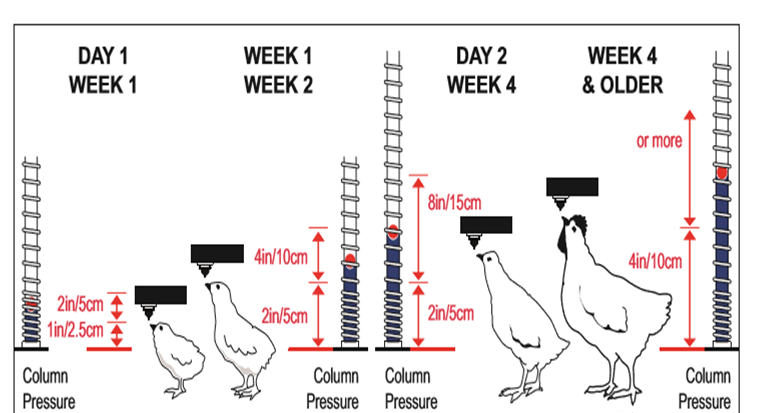
Feeding management
& nbsp; For newly hatched chicks, especially those that consume a lot of yolk during long-distance transportation, timely feeding can ensure that the chicks receive the necessary nutrients and lay the foundation for the development of important tissues and organs. Weight is an important measurement indicator,sevenThe main factor for not meeting the daily weight standard is insufficient intake of feed. The formula, shape, quantity, and feeding space of feed are important influencing factors.
1. Formula
Please strictly follow the recommended formula of Kebao Company. Kebao Company's formula level is an optimized formula obtained through extensive experimentation and analysis of the nutritional level of the feed used in practice. The nutritional parameters of the chick feed recommended by Kebao Company in the first four weeks are metabolic energytwo thousand eight hundred and fiftyBig card/Kilogram, crude protein19%, digestible lysine0.93%Some companies use feed formulas similar to broiler chickens to significantly increase energy and protein, such as energy, in order to gain weightthree thousand and one hundredAbove, protein21%~23%It may have adverse effects on the first born chicks. Because in actual production, the digestibility of feed raw materials is a very important indicator, and various raw materials have some anti nutritional factors to varying degrees. The use of enzyme preparations to promote digestion is crucial for improving digestion efficiency. For example, the presence of mannan in soybean meal may pose a threat to the occurrence of "sticky anus" in first-time chicks with poor digestive function caused by long-distance transportation. Therefore, the use of enzyme preparations and the total proportion of soybean meal should be considered in the formulation.
two & nbsp;Material type
The recommended opening materials all use crushed materials. Granulation is beneficial for reducing harmful microorganisms such as bacteria remaining in the raw materials. Crushing after granulation is to meet the feeding needs of young chickens. The Kebao Chicken Handbook recommendstwenty-eightThe material type will only be changed to granular material after a certain period of time. In actual production, iftwenty-eightAfter eating, using the feeding line can continue to use crushed materials, which can moderately prolong the feeding time and help control the uniformity of weight.
three & nbsp;Quantity and material level
Zhou suggests free feeding, and Kebao recommends an average weekly feed intake of21~26Ke. copal
The chicken breeding manual recommends laying padding paper on the ground, which can cover each chicken for the first three daysfortySpread the feed in advance in the chick rearing area50%In practical operation, we suggest evenly spreading the place100%Nurturing area to increase the feeding rate of the sky. Due to biosafety risks and material quality considerations, we do not recommend using old newspapers or other refurbished paper. The density of chicks placed in the brooding area should not exceedseventyonly/Square meters. Many companies adopt local area brooding, and the density of the chicken coop in the first few days is4 0A chicken/Square meters, and thensevenreachfourteenThe sky increased to the entire chicken coop for raising chicks. The time for raising and expanding chicks depends on the environmental conditions of the chicken coop.
four & nbsp;reviewEstimatechickenGroup feeding situation:
After moving intwenty-fourCheck the fullness of the crop within hours, mainly classifying and statistically analyzing the following three situations:oneThe crop is full and soft (representing normal feeding and drinking of chickens);twoThe crop is full but noticeably hard (representing only eating without drinking water);threeEmpty crop (indicating that the chicken has not been able to eat).
Usually sampling statistical categories“one”The proportion of the total number of inspected chickens as an indicator is required in the following table:
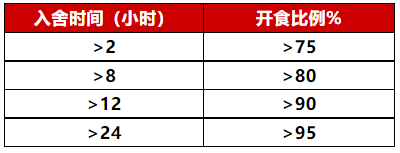
summary
summaryRegarding the breeding of newborn chicksChujieDuan's PasskeyPoint:
one ringIs the ambient temperature suitablechickAnal temperatureDetect as standardaccurate40~40.6centigrade,104~105Freshly hatched chicks should be placed in a stable temperature breeding location, usually in the middle of the pen;
2. Keeping drinking water at a lower temperature is more conducive to chicken feeding (temperature is...)10~14Celsius), so the water line needs to be flushed frequently, and the water storage tank should be placed in the operating room rather than in the chicken coop;
three & nbsp; Use the entire brooding area for feeding(100%Open dining area,fortyThe uniform distribution of feed and the evaluation of crop fullness are important indicators for monitoring the feeding status of chicks. When the crop fullness does not meet the standard, the environmental conditions and distribution of water and feed should be checked and adjusted in a timely manner.
Kebao's One Day Agechick,In hatchingsiteAccording to motherchickenweekAge advancementOkay, dividedclassDifferent weeksAge rangeNumber of paragraphs usedThe word mark is on the box.onerepresentativethirty-twoBefore the week,tworepresentative33~45Zhou,threerepresentativeforty-sixMore than a week. If possible, please try to feed according to the markings in separate columns.







